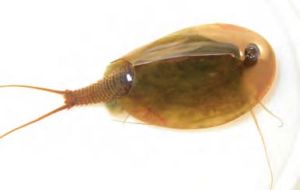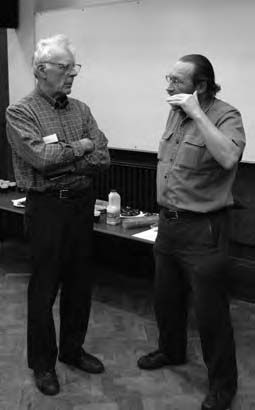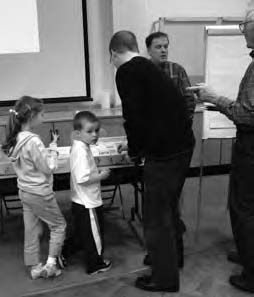|
This meeting arose out of a suggestion to Craig Macadam that he should give a talk to Scottish conchologists about the work of the Mud Snail Study Group on establishing the status of Omphiscola glabra in Scotland. Craig then proposed broadening the meeting to include other invertebrates of temporary waters, and so this joint meeting with the Royal Entomological Society took place in the comfortable surroundings of the lecture theatre at the Perth Museum. The first speaker was Larry Griffin of the Wildfowl & Wetlands Trust, who described the rediscovery of the tadpole shrimp (Triops cancriformis) at the Caerlaverock reserve on the Solway coast near Dumfries. This prehistoric creature (it has been around for some 200 million years) bears a remarkable resemblance to the horseshoe crab (Limulus) (Figure 1, see F on page 15), but is definitely a freshwater species. It appeared in just a single pond on the Caerlaverock reserve after heavy August rains in 2004, and has not been seen there before or since. It has, however, been found sporadically at other sites along the Solway coast in the distant past. Apparently it can survive as eggs in dried-up mud for at least 50 years, and completes its lifecycle in 12–14 weeks, obviously a good strategy for an animal living in such marginal habitats. The next speaker was Thomas Huxley, who described the habitats of a number of species of water bugs (Hemiptera), and entertained us with his demonstrations of the various methods needed to find different species. More seriously, it was a reminder that there is no single standard way of finding the various species in any group. Some species of Hemiptera will colonise even the most unpromising sites, such as water-filled tractor ruts – temporary waters indeed! After the tea break, during which there were many animated discussions (Figure 2), and an opportunity to examine some of the Perth Museum shell collection (Figure 3), the last speaker was Craig Macadam, who told us all about the Scottish Omphiscola glabra project. This aims to establish the current status of the mud snail in Scotland, examine old sites to see if the snail still lives there, look at other likely sites to see if they also harbour mud snails, establish a captive breeding programme, and perhaps ultimately stock appropriate new sites with captive bred stock. So far, mud snails have been found in a number of sites where they had previously been reported, as well as a few new sites. Other sites where O. glabra was recorded in the past have not yielded these snails so far; this could be because of over-collecting in the past, but is more likely to be due to habitat changes, in particular drainage. In at least one case it has not been possible to identify the site described in the older literature. Most records of the mud snail are from sites that dry out readily, and the best time to find the snails is late winter/early spring, when water levels are likely to be at their highest. Nevertheless, they are occasionally found in anomalous habitats such as ponds that remain full of water throughout the year. When temporary waters do dry out, the mud snails burrow into the mud and remain there until the water returns. They become active again within a few minutes, and will start breeding very quickly. There is no problem about breeding them in captivity, and several primary schools have reared their own pet mud snails. Although there is no difficulty about returning captivebred mud snails to the sites from which they came, Scottish Natural Heritage has so far vetoed attempts to use them to (re)introduce mud snails to likely looking sites. This was the end of the formal part of the meeting, but people found it very stimulating, and informal discussions continued for some considerable time afterwards. Nor was this a purely Scottish event; one person had travelled all the way from the south of England to be with us and make a valuable contribution to the discussion. |
Fig. 1. The tadpole shrimp, Triops cancriformis. Photo kindly provided by Larry Griffin. See page 15, F.
Fig. 2. Animated discussion between Thomas Huxley and Keith Bland during the tea break. Photo by Adrian T. Sumner.
Fig. 3. Budding young conchologists study items from the Perth Museum to find out how to arrange their own collection. Photo by Adrian T. Sumner. |
Invertebrates of Temporary Waters
Issue
11
Page
13



